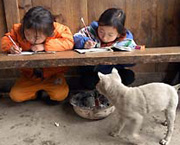|
 |
| Children of China's Dong minority group are
doing their home work in the remote village of southwest Guizhou
Province on February 28, 2005. |
By the end of 2004, 93.6 percent of Chinese children are receiving nine
years of compulsory education, marking further advancement of China's
educational cause.
Han Jin, a senior official with the Chinese Ministry of Education, said
this at a press conference, adding that achievements were also made in
five other aspects of China's education during the past year.
According to 2004 statistics, the enrollment rate of China's primary
education was 98.95 percent, 0.3 percent higher than the previous year.
Enrollment rate for girls, in particular, was 98.93 percent, which was
almost the same with that of boys.
In high schools, the enrollment rate was also an obvious increase. Last
year, about 13.7 million students were received by high schools, which
made the total number of on-campus students reach 36.07 million. In the
meantime, professional training schools at this level also developed in a
stable way, as 14,500 schools enrolled a total 5.48 million students in
the year 2004, up 6.28 percent over the previous year.
In 2004, the size of China's higher education was further enlarged with
2,236 schools of various types and more than 20 million on-campus
students, Han said The enrollment rate of higher education was 19 percent,
two percentage points higher than the previous year.
China also made great efforts in kindergarten education and special education
for disabled children, Han said. In 2004, number of
kindergartens in China reached 117,900 with the newly added 1, 509.
Special schools for disabled enrolled 50,800 people, making the total
number of on-campus students 371,800.
Private schools, under the protection of newly issued laws and
regulations, were boosted. By the end of last year, China had 78, 500
private schools with 1.77 million students. Around 1.4 million people
chose to study at private universities and colleges.
Han also noted that the illiteracy rate has been limited to below four
percent.
Nevertheless, the old problems in China's education still exist, such
as the gap between educational investment and people's demand and the
difficulties in education in rural areas, Han said.
(China Daily) |
